Any attempt to find the “best CMS” is condemned to fail. In truth, there are thousands of content management systems available and each offers its own pros, depending on your organization’s aims and needs.
Analyzing CMS Hub, WordPress, Joomla, and Drupal? Research demonstrates CMS Hub is preferred for enterprises, WordPress for blogs, Joomla for memberships, and Drupal for high-traffic sites with lots of data.
These are just a few of the website possibilities with a CMS. Here we’ll explain different criteria for selecting a CMS platform for your firm. Then, we’ll go over some CMS systems so you can find the perfect match for your specific website needs and objectives.
Picking the Right CMS Platform
Freelancers and businesses that don’t possess the HTML, CSS, and JavaScript required to code a website may find that an easier method of creating a custom web design is by using a CMS platform and website builder. These offer a variety of features, pre-designed templates, and extensions to make customizing a website simple and straightforward.
Each of these tools presents different approaches for building and managing a website, so let’s examine them more closely and determine which one is correct for your site.
CMS vs. Website Builder
If you’re looking for a comprehensive web host and website construction platform, try a website builder. You can acquire a custom website domain, personalize your page’s outlook, and create interactive, multimedia websites with features such as animations and scrolling impacts. While you concentrate on design and material, your hosting platform will manage your website’s maintenance, security, backups, and much more.
In exchange for this uncomplicated usage, you must make a few sacrifices. Website builders lack the content organization features, functional expansion, and individualization settings that you can find in CMS programs. Thus, website builders are great for conventions, musicians, eateries, and other users who want to form multimedia-rich websites with speed.
For more custom settings and feature updates, use a CMS. By utilizing a CMS, you can direct the design of your webpage, add media, arrange content by labels and classifications, handle distinct users, alter your website’s code foundation, and many more. Although setting up and launching your site will take longer, you can craft and supervise a larger and more intricate website, with the ability to expand eventually.
If you have determined to build a website with a CMS, then you can further limit your choices with the subsequent criteria.
5 Criteria for Choosing a CMS
Selecting the right CMS platform for your business is a crucial step and should be aligned with your site’s requirements and objectives. Key factors to keep in mind include user-friendliness, customizability, security, pricing, and popularity. If a platform offers the features you’re seeking but comes at a hefty cost, then it’s not the ideal choice. On the contrary, a low-cost solution that would require immense maintenance and additions to fulfill your needs isn’t optimal either. Now, let’s delve into each of these criteria a bit more.
Ease of Use
Usability holds a prime place when deciding on a CMS since it considerably affects the adoption rate and workflows of your organization. A perfect platform should be easy to access and manage for all stakeholders in your team. For example, if both content marketers, and developers, will be active in the backend of the CMS, you need features that enable hassle-free work for both. Search for a CMS that sports a WYSIWYG editor for practical content creation and editing as well as modules for developers to quickly add custom code.
Customizability
Despite prioritizing user-friendliness, customizability mustn’t be overlooked. A highly flexible CMS like WordPress, which offers a myriad of customization options, is ideal for businesses that plan to expand gradually. Consider what customization options are available in the dashboard, how many extensions can be integrated, and if you are allowed to make adjustments to the source code. If you want to build a website with limited development resources, most CMS have pre-designed themes that you can customize accordingly.
Security
When deciding on a CMS, you ought to ascertain your content, users, and visitors are safe. To do this, enquire what role the platform will assume and what role you will have to assume to protect your site. Do you need to manually back up your site? Update the software? Put in place security add-ons? Purchase an SSL certificate? If you don’t have the time or knowledge for security best practices, then you need a system with foremost security protocols, features, and teams in place.
Pricing
Budget is an integral element of almost every business decision. With CMS, you need a solution that meets your needs, the expectations of your visitors, and your finances. Fortunately, multiple platforms offer different tiers of plans with adjustable resources, like WordPress’s free CMS. Furthermore, most of them allow you to upgrade according to your growth, indicating that the CMS can handle changes in the business.
Prevalence in the Market
Having knowledge of what other successful brands in your industry are using can help refine your choice. Looking at the CMS platform and websites of these brands can give you insight into their strategies and yours. Additionally, you can ascertain the value of a particular CMS from the list of prominent clients. Hence, researching security standards, the features of different CMS, and the market trends in your industry will help you make the right decision.
Popular Content Management Systems
- WordPress
- Drupal
- Joomla
- Shopify
- Magento
- Magnolia
- Optimizely
- PrestaShop
- TYPO3
- Crownpeak
- Contentful
- Storyblok
- concrete5
- Contentstack
- Webflow
1. WordPress
Originally intended as blogging software, WordPress has become the most popular CMS platform to date. Open-source in nature, WordPress is often used in industries that focus on editorial features like articles and blogs. Its simple user interface and website themes make it great for small businesses that are just starting out with web strategies or have limited design knowledge.
Best CMS for
For small to large businesses that require editing teams, personal websites, and blogging needs, WordPress is a great option.
Key Takeaways
- Beginner-friendly and easy to use.
- The largest collection of plugins and themes.
- Can take time to maintain the plugins and site.
- Varied costs including domain registration, hosting, and premium plugins and themes.
Ease of Use
WordPress is user-friendly for those without coding knowledge. Its dashboard is simple to use with options to tweak the site’s appearance, install a plugin, change the permalink settings, add blog posts, and more.
The new editing interface, Gutenberg, uses drag-and-drop capabilities so users can develop pages with media without the assistance of custom code or plugins.
But if you need anything more advanced such as a list of random posts in the sidebar, you will need to install the appropriate WordPress plugins or add code to the files. This can be a challenge for those without coding knowledge.
Customizability
WordPress is highly customizable with 57,000 plugins available from the official directory and 31,000 WordPress themes available from the official repository and third-party marketplaces.
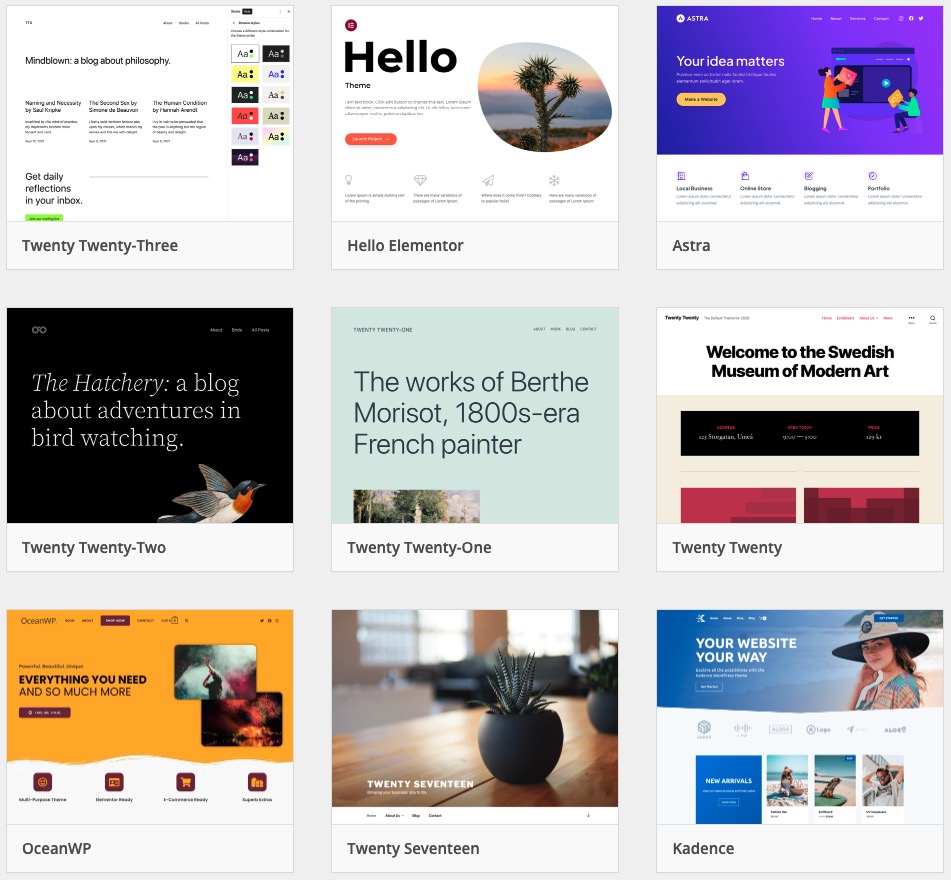
These plugins and templates let anyone with limited technical knowledge create fully functional websites.
Ensure that the plugins and themes are up-to-date and compatible with the site to help keep it secure.
Security
Any CMS is susceptible to hackers and malicious users and outdated code increases this risk. WordPress sites that are out of date account for 49% of the infections in 2019.
Moreover, outdated plugins can compromise security. In 2019, plugin vulnerabilities accounted for over half of the known entry points for hackers.
It is not only important but mandatory to keep all software and plugins up-to-date. WordPress’ built-in update system makes this process easy. However, some updates may not be compatible with all extensions on the site which can take more time to upkeep and manage, especially for larger projects.
Pricing
WordPress is a free download. The costs occur from domain registration, hosting though, and any premium plugins and themes.
Average Cost: $11 to $40 per month + one-time fee of $200
Brands Using WordPress
TechCrunch
TechCrunch is an example of a website that uses the WordPress CMS to publish tech-related news, articles, and videos. Its homepage is centered on one large image with highlighted stories appearing with just text-based headlines. There’s also easily-navigable space for ad space.
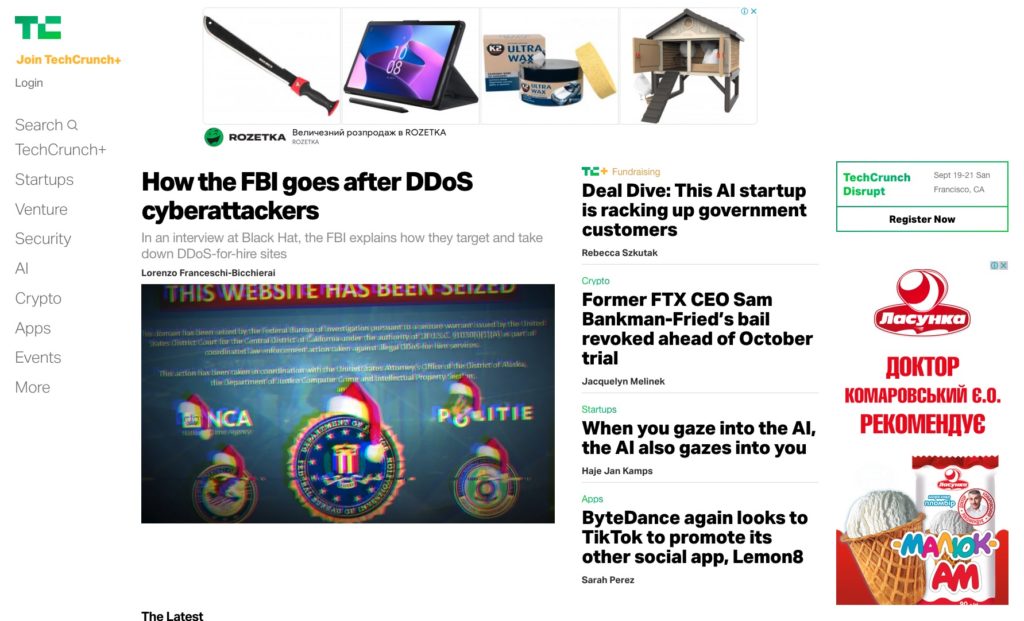
In a 2018 announcement of the site’s redesign, TechCrunch noted why they’ve stuck to WordPress. “It handles content authoring, delivering, and caching very well. Plus, its massive community makes it so that our small team doesn’t need to reinvent the wheel and do it better than WordPress already has”.
IKEA
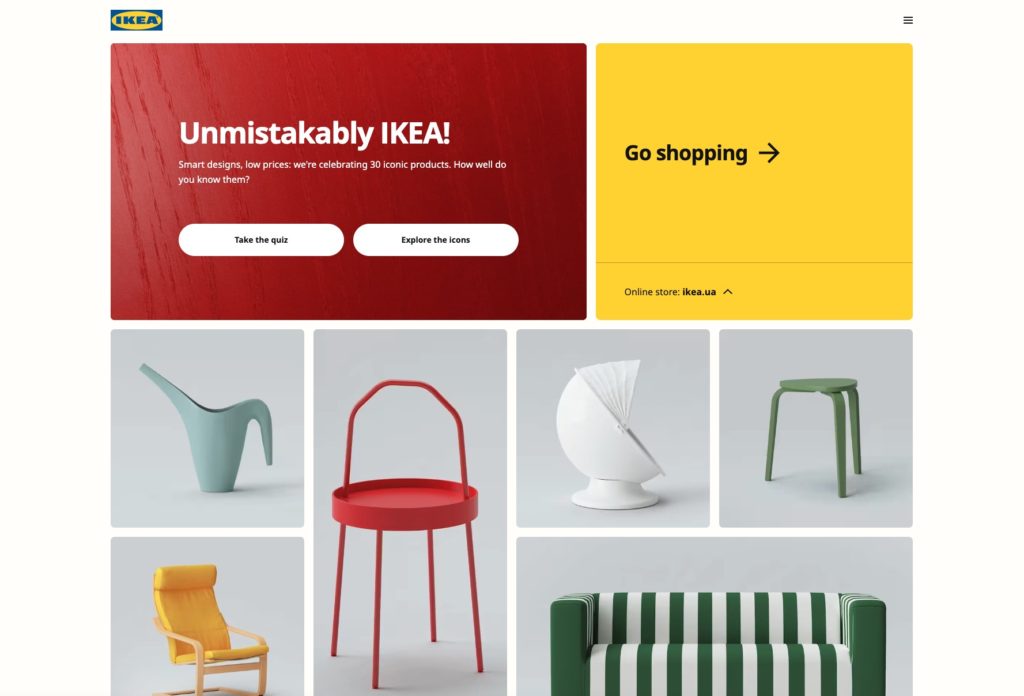
Internationally-recognized furniture and home goods retailer, IKEA, also makes use of the WordPress CMS. Being a highly visual brand, Ikea’s pages make use of a grid system with most page space being occupied by images with text overlays.
2. Drupal
As an exceptionally versatile, open-source CMS, Drupal is an ideal choice for developers, marketers, and agencies. It lets inexperienced marketers quickly create a website from a template, while developers can utilize it for tonnes of data and high traffic.
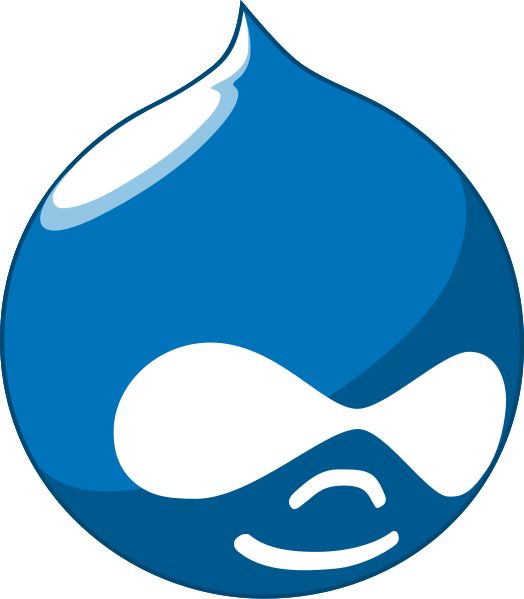
Best CMS for
Those with significant technical resources
Key Takeaways
- This applies mainly to developers
- An extensive selection of configurable modules and themes
- Significantly higher security for open-source platforms
- Customizing the site may cost thousands
Ease of Use
Developers designed Drupal for developers, so if you want to take advantage of its full potential, you’ll need a basic knowledge of HTML, PHP, and CSS. Also, setting up and configuring the site takes longer than with WordPress.
Customizability
Drupal’s directory has more than 46,000 modules and its theme repository contains thousands of free themes. Even though the number is smaller than WordPress, most modules and themes are highly adjustable, allowing you to create a site precisely as you envision it—if you possess the necessary coding skills.
Security
Data from the Common Vulnerabilities and Exposures survey shows that Drupal has fewer incident-to-market-share instances than any of the other open-source platforms (including WordPress and Joomla). To make sure of the platform’s secureness, a devoted group of 40 community members release bug fix and security updates per month, and further on an annual basis.
Unfortunately, site owners will have to download the latest update manually and stick to best practices if they are to stay on the safe side.
Pricing
The Drupal download is as free of charge as WordPress, but the amount of money needed for building and managing an adequate website tends to be much higher. Unlike most WordPress plugins and themes, Drupal’s are particularly adjustable, but demanding coding skills are required to make the website how you initially intended.
Average Cost: $15,000 to $42,000, depending on the scale of the web project.
Brands Using Drupal
UNICEF
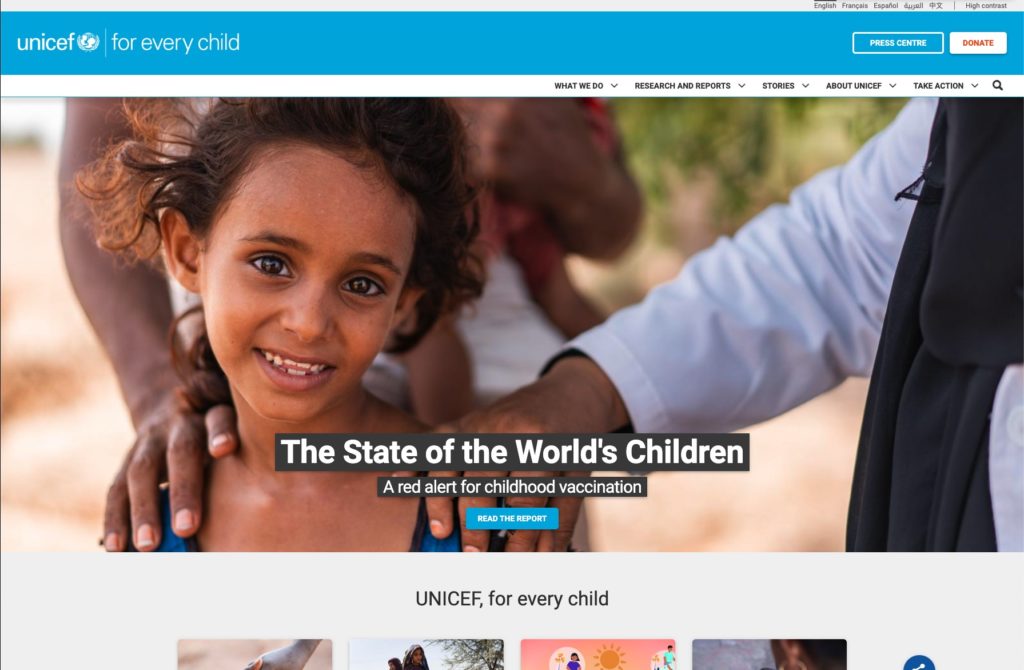
The UNICEF page is a clear demonstration of how adequately open-source platforms can be used to set up a high-functioning website with an attractive design.
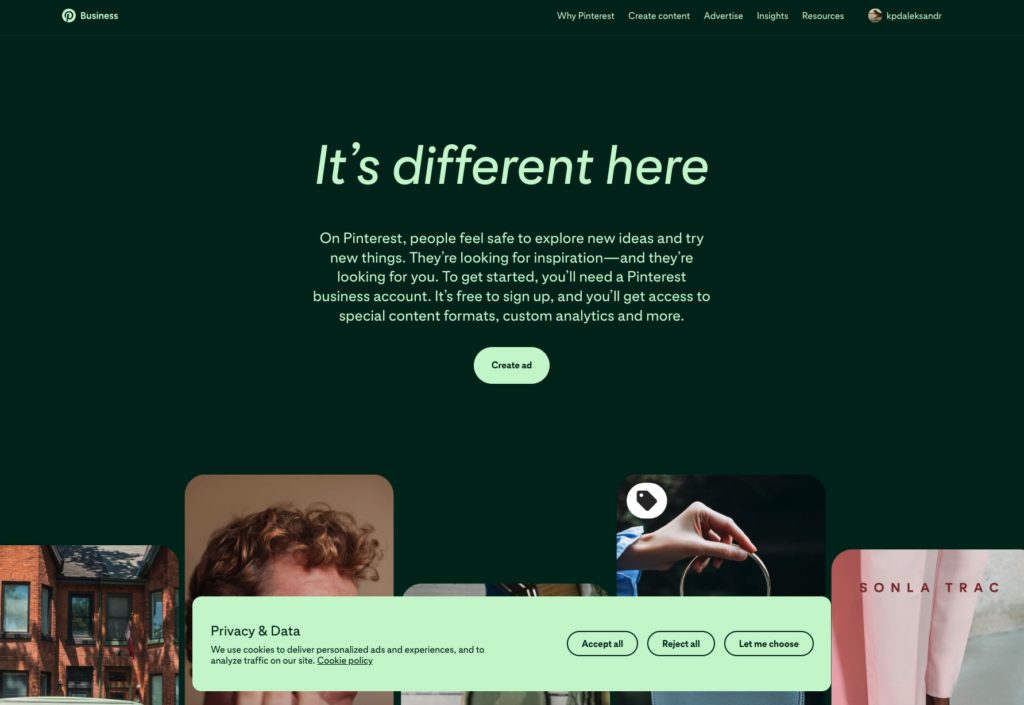
Pinterest’s business page is powered by Drupal, too. It showcases various promotional tips and resources related to advertising on the platform. Unconventionally, this page was designed for scrolling, relying on minimal text and with an emphasis on visuals, color, and calls-to-action. Such layout makes the webpage feel more immersive and entertaining.
3. Joomla
Designed to lie somewhere between Drupal and WordPress in terms of ease of use and cost, Joomla combines versatility and user-friendliness in one package.
Best CMS For
Suitable for larger companies and tech-savvy individuals alike.
Key Takeaways
- 6,000+ extensions available, though installation & management can be tricky.
- No built-in features for scheduling automatic updates, leaving sites vulnerable.
Ease of Use
Joomla has impressive built-in features, allowing users to manage hundreds of users, build pages in multiple languages, and create custom post types. Settings for articles, banners, menus, media, and SEO can be adjusted as necessary.
Complex sites can easily be built with Joomla, though doing so can be challenging for beginners. Those with experience in web development can better leverage the features Joomla provides for more substantial websites.
Customizability
In addition to the features Joomla includes, 6,000+ extensions can be downloaded for enhanced control over your site. Unfortunately, CVE data on WordPress, Joomla, and Drupal shows that Joomla has the most found vulnerabilities since 2005.
The platform’s security team regularly releases security patches, but without any built-in features for scheduling updates, your site may remain vulnerable. In fact, Sucuri’s 2019 report indicates that 90% of websites with infections were running outdated versions of Joomla.
Pricing
Joomla requires payment for domain registration, hosting, themes, and maintenance to create and run a website. Website hosting and design costs tend to sit somewhere between WordPress and Drupal. Overall, as reported by CMS2CMS, Joomla sites cost around $700-$6,500.
Average Cost: $700 to $6,500 to create and maintain
Brands Using Joomla
Nintendo Nordic
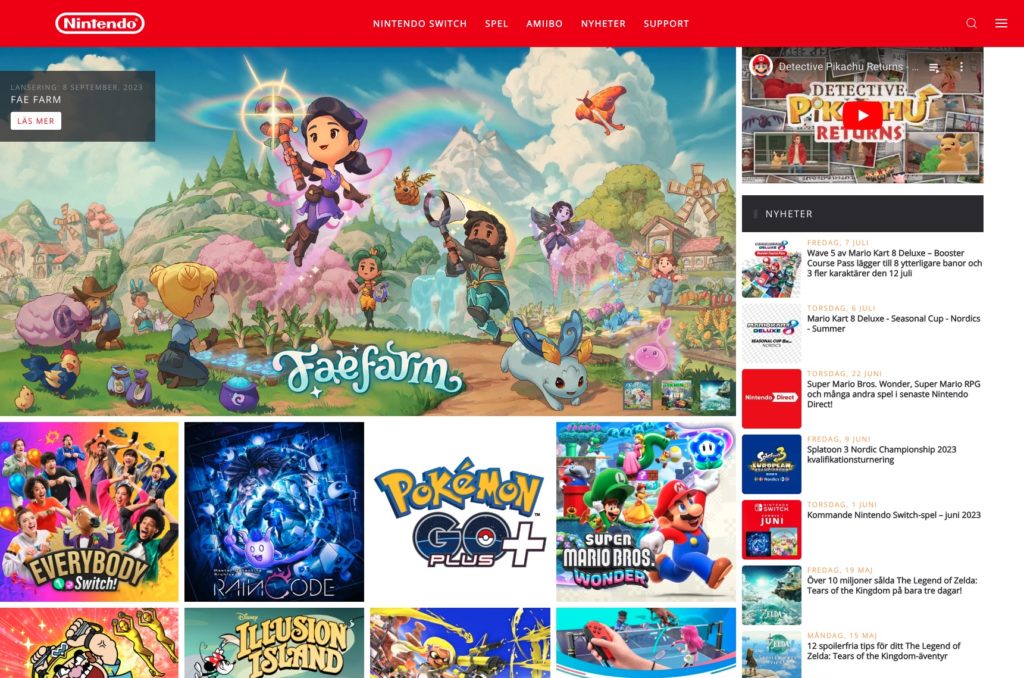
Nintendo’s Nordic sites are powered by Joomla. Similar to the American sites, this CMS allows them to remain consistent with their branding, while still being visually appealing.
4. Shopify
Shopify is an e-commerce platform designed specifically for online retailers, allowing them to create and manage their stores.
Best CMS for
Ecommerce and beginning sellers
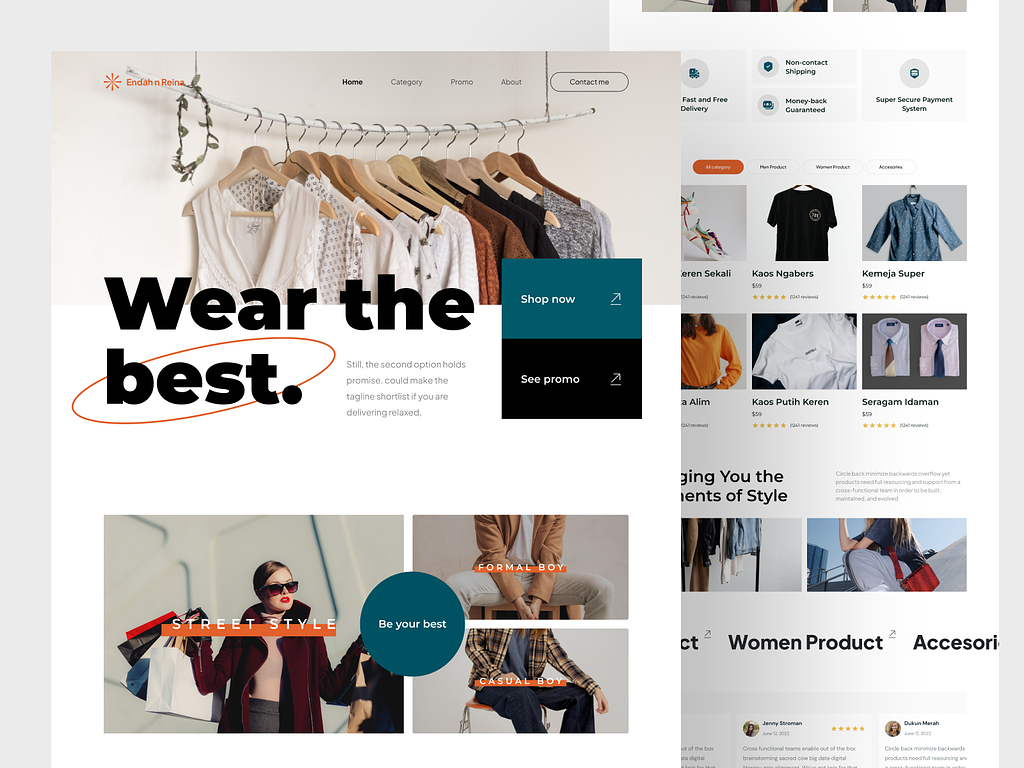
Key Takeaways
- Ideal for novice shopkeepers
- Limited range of themes and apps
- Comes with automatic backups and software updates
- Offers three premium plans, with prices from $29 to $299 monthly
Ease of Use
Much simpler than creating a site on WordPress.com, Shopify makes it easy for novice shop owners to set up and run an ecommerce store. Although they’ll lack some of the control over appearance and functionality, a suite of features, security, and customer support will be available to help them manage their venture.
Using Shopify’s blogging tools, customer reviews, payment options, abandoned cart recovery, they can quickly get their store underway. Additionally, Shopify handles backups and software updates.
Customizability
In exchange for convenience, some customization options may be lacking. As Shopify is proprietary, its code cannot be modified.
As a workaround, users can select from over 70 themes and around 5,700 free and paid applications from the Shopify store.
Security
In order to accept payments from Visa, Mastercard, American Express, and Discover, the store must be PCI compliant. With Shopify, users can avoid the time and money spent on obtaining a Level 1 PCI certification, as all Shopify stores come with automatic certification.
Moreover, Shopify takes care of general security matters, manages backups, and updates the software as needed.
Pricing
Shopify has three paid plans, the least expensive of which begins at $29 each month. This package includes hosting, SSL certification—with a Shopify subdomain of username.shopify.com—and more. An additional fee will be required if the website owner wants a custom domain.
Upgrading to higher packages will provide more seats and features, such as rewards systems and enhanced reporting, and the priciest is $299 monthly.
Average Cost: Plans run from $29 to $299 per month
Brands Using Shopify
Briogeo
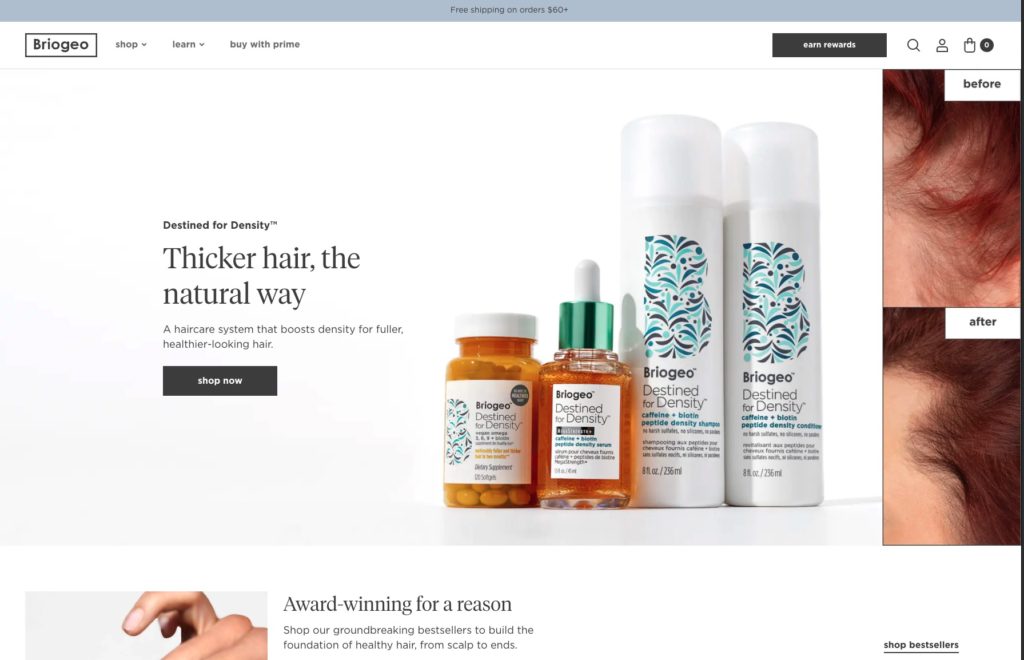
An example of an ecommerce website made with Shopify is Briogeo, a haircare company that only uses natural ingredients in its products. Its webpage serves as a great showcase of the platform’s capabilities, with product displays, mega menus, user accounts, checkout, image collages, blog, and even a rewards system.
5. Magento
Magento, an eCommerce platform owned by Adobe, offers myriad options to tech-savvy store owners. We’ll focus on Magento Open Source — more popular — here.
Best CMS for
Experienced ecommerce store owners and sellers.
Key Takeaways
- Learning Magento and its features takes time, especially for beginners.
- 3,800 add-ons found in Magento’s Extension Marketplace.
- Security patches and updates require manual installation.
- Average Magento store starts in thousands.
Ease of Use
Like Drupal, Magento Open Source allows you to build the exact site you want. But, understanding and exploiting its features and extensions demands experience in website development or a willingness to invest significant time.
Customizability
Install or integrate any of the 3,800 add-ons available in the Magento Extensions Marketplace to extend the site’s utility and power. Sync customer and order data to your CRM or raise your site’s SEO — Magento makes it a snap.
Security
Magento rolls out patches and security updates to address vulnerabilities. Utilize its free Security Scan tool to be advised of their availability and quickly install. All too often, site owners don’t install; research shows that Magento Websites were 87% out of date when found to be hacked.
Pricing
Magento Open Source is free, though better apps and themes are more expensive than WordPress. Additionally, Magento is complex. This invariably requires the help of a developer; a basic store can begin at $20,000 and climb to $40,000. Magento Commerce, the enterprise-fitted version, starts at $22,000 annually.
Brands Using Magento
Yakima
Yakima, leading bike rack and outdoor products provider since 1979, used Magento to redevelop its site and enhance online sales. Vast mobile-optimization and customizations — such as a make and model search tool — were made possible.
Boodles
Boodles, a luxury jewelry company, chose Magento for its open-source capability and the opportunity to capture younger buyers. A fully-visual, mobile-adapted site, with ecommerce integrations and an Instagram Stream block, amplifies the company’s presence in the jewelry market.
6. Magnolia
Magnolia is a comprehensive system which provides multi-site, multi-language, and multi-channel digital services. It offers two types of service: cloud and client. The cloud-based service helps businesses to launch projects faster, while the client-hosted option gives them the opportunity for Java development and specific integration.
Best CMS for
Large enterprises, startups, and ecommerce
Key Takeaways
- User-friendly with customizable options to suit needs
- The Pages App lets users have complete creative freedom
- Costs need to be requested from sales representatives
Ease of Use
Magnolia is not considered as easy-to-use as WordPress; yet, they provide a series of tutorials to simplify navigation. The interface’s intuitiveness depends on the type of service they choose: cloud or client.
Therefore, businesses that lack technical knowledge are advised to prefer the cloud-based choice.
Customizability
Magnolia is based on modules and offers great customizability, letting organizations tailor their sites to meet their own requirements. Through Java customization, users can modify their pages, user interface and make server filters and more. It also integrates with several external services, like Google Analytics, React and Amazon S3.
Security
At Magnolia, the security is guaranteed by Java Authentication and Authorization Service and it is always checked if the user has access to a webpage, document, or data. The security app helps to manage this.
For external security, Magnolia suggests the Apache Web Server as a proxy for the application server.
Pricing
The cost of Magnolia is personalized and needs to be obtained by contacting the sales representatives.
Average Cost: Contact for a website quote
Brands Utilizing Magnolia
BMW
When it comes to BMW dealerships, Magnolia’s CMS is used to create specialized interaction platforms for information exchange. Implementing their innovative “What You See is What You Get” (WYSIWYG) editing mode as an uncomplicated method of content management, the BMW team opted for Magnolia’s services. The CMS is hosted on BMW’s in-house servers, ensuring the data’s security is kept intact.
Atlassian
In the case of their international website, Atlassian utilized Magnolia’s CMS for their rebranding and launch. Features such as in-build translation and templating were implemented which resulted in 41 pages in 10 different languages. The content team was able to create new campaigns and reach out to translators via the workflow tool and release their work, all without developer support.
7. Optimizely
Well-known for its A/B testing functions, Optimizely’s suite of marketing tools has been gradually expanding. After being acquired by Episerver last year, the two firms together combined their capabilities to create the Optimizely Content Cloud.
This tool lets editors develop and share attractive content with ease and provides developers with a fast way to create and launch new pages and sites.
Best CMS for
Organizations that require fast, efficient solutions to build new websites or pages.
Key Takeaways
- Completely compatible with multiple coding languages – not just one.
- Time-saving tools like “publish everywhere” with expedited go-live time.
- Headless content management for versatile projects.
- Different backend & front end management systems.
- Multiple package offers include everything you may need.
Ease of Use
Although their tutorials are somewhat sparse, Optimizely’s visual editor is straightforward in its usability. Like Magnolia, it offers a WYSIWYG platform that displays how the project will appear to viewers. Additionally, page elements can be easily modified with just a few clicks. With the “publish everywhere” feature, teams can swiftly create content once, and repurpose it for a variety of channels.
Customizability
As it is headless, this CMS allows for maximum customizability. Optimizely can, therefore, support an unlimited number of platforms and layouts. Make use of their features flag for real-time roll-outs across the sitewide, or deploy the killswitch if the launch doesn’t quite go as planned. You can even tailor rollouts to particular audiences or the entire crowd. Whether you’re working on a new project or honing existing ones, Optimizely gives you the control to make any adjustments to suit your needs.
Security
All exchanges appearing from visitors and end-users on Optimizely products are secured by Transport Layer Security (TLS). Additionally, Optimizely offers a bug bounty system to motivate reporting of security threats concerning their product.
For extra protection, Optimizely requires that their personnel utilize single sign-on as well as two-factor authentication to access any data that your business has stored. This guarantees that no one, inside or out, is able to access your data without authorization.
Pricing
Optimizely presents a range of packages. Prices are available upon request. All of these package features must be combined, however you may not find every single capability within just one offering.
Average Cost: Reach out for a quote
Brands Using Optimizely
Absolut
Set on eliminating server management, Absolut implemented Optimizely to host all their sites and shifted to the Content Cloud. With Optimizely’s capabilities, Absolut had the ability to release at a more agile pace and lessened their launch time. Using Optimize’s Content Cloud, both marketing and devops teams could oversee content from a unified place, as well as launch new sites in half as much time with fewer resources.
8. PrestaShop
PrestaShop is designed to occupy the middle ground between Magento and Shopify, combining the power of the former with the simplicity of the latter.
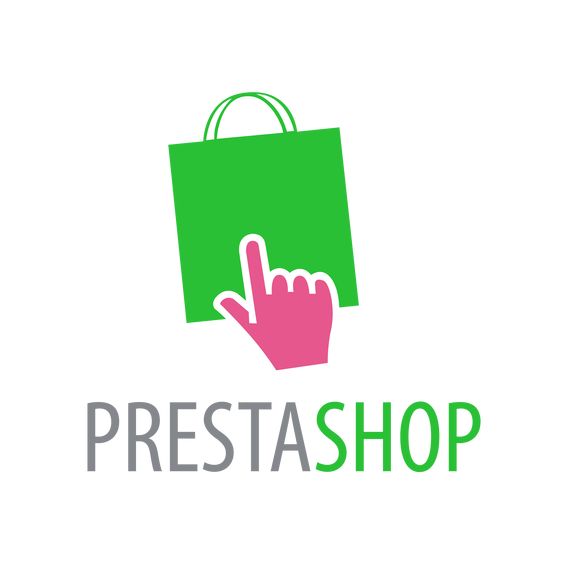
Best for
Shop owners and sellers with some technical experience
Key Takeaways
- An ideal blend of Magento’s complexity and Shopify’s simplicity
- Over 6,000 add-on modules and themes available
- SSL must be enabled and software must be regularly updated
- Expensive add-ons and support plans
Ease of Use
Getting started on PrestaShop is more complicated than Shopify since it is an open-source platform. You will need a hosting provider and to create a database and upload the software via FTP. Additionally, PrestaShop offers more out-of-the-box features, making the dashboard more complex.
Customizability
PrestaShop can customize messages for out-of-stock items and enable the shop in 65 languages, as well as configure coupons. Furthermore, its marketplace offers over 3,900 modules and 2,200 themes, allowing you to build an expansive ecommerce store.
Security
For security, enable SSL, regularly update the software, add code to your .htaccess file, and follow other safety protocols. Also, you can opt for Security Pro, which provides a firewall, protection against DDoS, two-factor authentication, anti-SPAM, anti-malware, and automatic backups.
Pricing
PrestaShop is free to download, but you must pay for domain, hosting, SSL certificate, and premium modules. A PrestaShop store typically costs between $53 to $560 per month, and you may need to pay for a support plan, ranging from $279 to $1,299.
Brands Using PrestaShop
Freshly Cosmetics
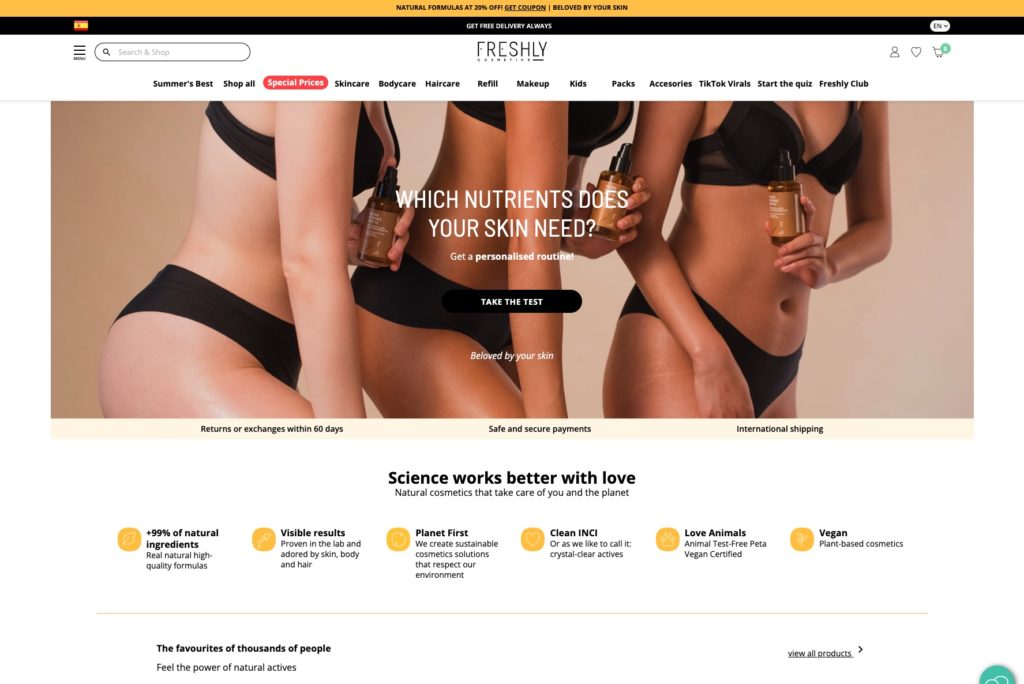
Freshly Cosmetics’ website highlights the ecommerce capabilities of PrestaShop. Its product pages are extensive due to its capabilities to provide customers with as much information as needed.
9. TYPO3
TYPO3 is an open-source CMS that’s designed specifically for constructing enterprise-level sites.
Best for
Programmers or groups with large technical resources.
Key Takeaways
- Demanding to learn platform, even for experienced users
- 6,000 extensions available in TYPO3 Repository
- Updates and maintenance is up to site owners
- Contractors and agency partners could be expensive
Ease of Use
TYPO3 furnishes more than 9,000 features out of the box. Such powerful functionality will enable you to create a complex multi-site installation — but it won’t be a breeze to install or set up. Even proficient users will need to invest a lot of time and effort into learning the platform.
Customizability
Despite its remarkable in-built capabilities, TYPO3 is lacking some typical features, like modules for including videos and adding image galleries to your page. To bridge the gap, you can incorporate any of the 6,000 third-party tools and services accessible in the TYPO3 Extension Repository.
Security
To aid protect your website, TYPO3 supplies built-in security components, compliance tooling, and frequent updates. The TYPO3 Security Team releases these updates regularly and informs site owners via email, yet upgrades and maintenance tasks are still the responsibility of users.
Pricing
According to T3Terminal, the average cost of a TYPO3 site lies between $100 to $30,000 annually.
Let’s go over the expenses related to constructing and launching a website on TYPO3. Apart from the normal rate of $15 for annual domain registration, hosting a TYPO3 site ranges from $6 to $69 per month. The average cost of premium TYPO3 templates and extensions is $49.
The biggest expense of setting up and maintaining a TYPO3 website is paying for a programmer or agency to take part in the process. Fortunately, you can find certified help right on TYPO3’s site. Unfortunately, the fees can range from a couple of hundred to some thousand dollars, depending on the extent and term of the web project.
Average Cost: $100 to $30,000 annually
Brands That Use TYPO3
Pearson
For user portals in Central and Eastern European countries, educational publisher Pearson used the TYPO3 CMS to digitalize their services and products. With this system, the company had the capacity to efficiently migrate its digital belongings, release its content to a desktop portal and a mobile app, generate a product catalog, and rebrand itself totally.
10. Crownpeak Headless CMS
Crownpeak’s CMS is user-friendly for beginners and those less familiar with tech. While the interface is simple to use, the CMS offers the same features as many of its more complicated competitors. Additionally, this hybrid headless CMS allows for a flexible integration into existing systems. Write and publish new articles, pages, and manage workflows easily in just a few clicks.
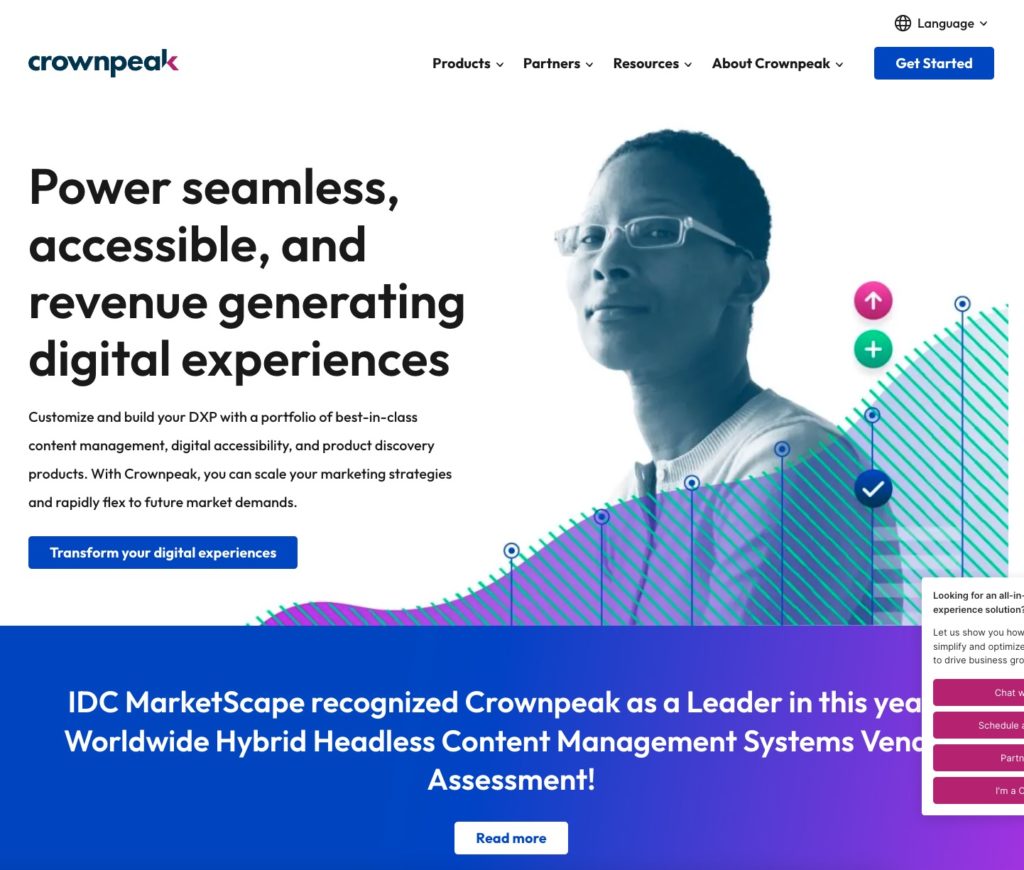
Best for
Small to Medium-sized companies with limited IT resources
Key Takeaways
- Set up easily without much IT support
- Use your preferred programming language due to the headless functionality
- Costs are determined by quote
- Security is paramount, due to extra protection offered by Amazon’s Web Services
Ease of Use
Crownpeak’s system is designed to be user-friendly. The content editor offers a WYSIWYG so authors can see a real-time preview of their draft. Additionally, admins have the ability to control author functions, guaranteeing that edits are accidental-free.
Overall, Crownpeak offers a simplified approach so users can get started quickly.
Customizability
The headless function of Crownpeak’s CMS means that companies can customize their integration according to their framework and preferred programming. Moreover, marketers can take advantage of their A/B testing options, plus serve content specifically aimed for a targeted audience easily across various channels.
Security
Crownpeak’s platform is built on Amazon’s Web Services to protect data. The system has also passed several independent audits, plus meets the FISMA security standard for U.S. financial institutions. For extra security, Crownpeak provides 24/7 monitoring, cloud firewalls, and the ability to move data quickly to another region in the event of a crisis.
Pricing
Due to the variety of customer needs, Crownpeak’s pricing is offered on an individual basis. Reach out to get a quote and expert advice on which products meet your business needs.
Average Cost: Contact for a quote
Brands Using Crownpeak
Texas Mutual
Texas Mutual, a workers’ compensation insurance company, switched to Crownpeak to manage their marketing efforts. To ensure their customers had an optimal user experience, Crownpeak’s automated QA reporting feature enabled them to meet accessibility compliance requirements.
11. Contentful
Contentful is a cloud-based headless CMS for enterprise companies that provides tools to create, edit, and manage content, as well as an API to ship it to any digital channel.
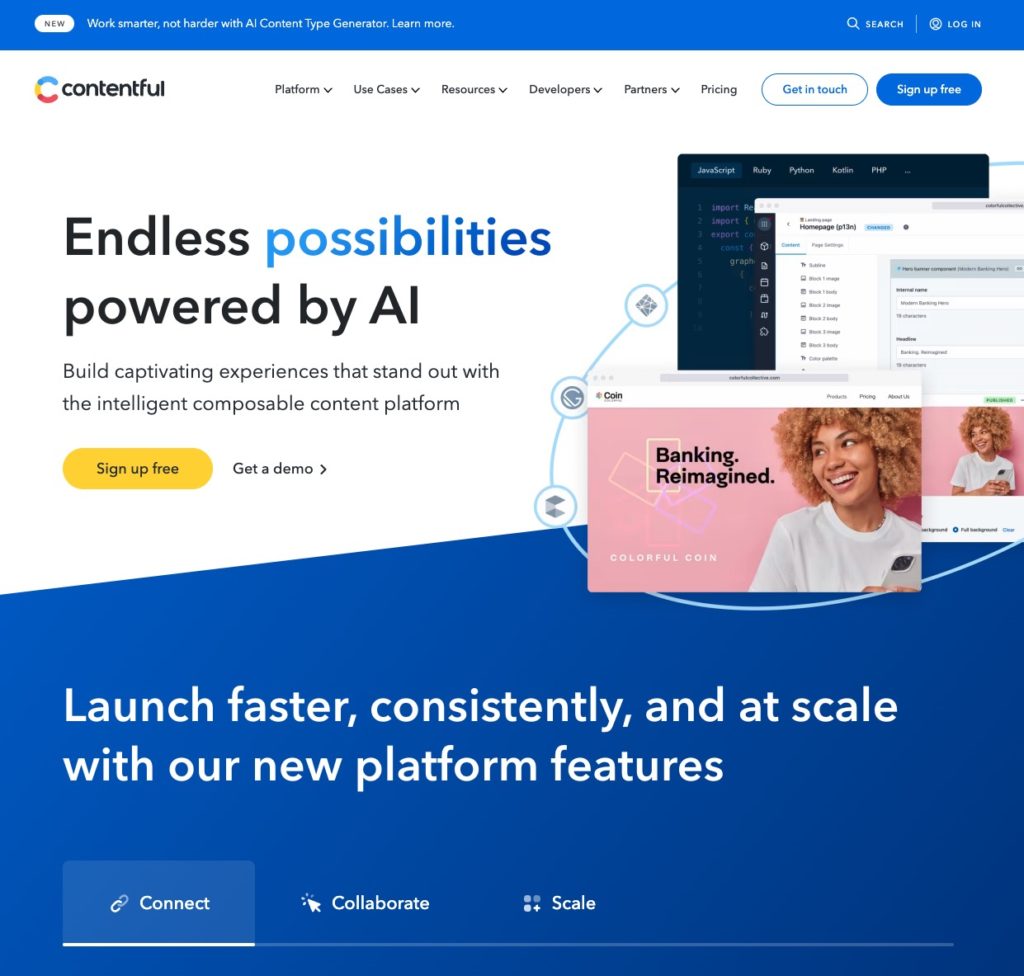
Best for
Medium to large enterprises with technical resources
Key Takeaways
- Enterprise-level headless CMS
- Uses an API-first design so there’s a steep learning curve
- Allows for a custom content model
- Security features provided by Amazon Web Services and Contentful
Ease of Use
With its content management tools, integrations with Dropbox, and advanced rich text editor, Contentful is designed to be easy to use for content marketers. However, the development side of Contentful – through its API – can be more difficult for non-technical users.
The API-first design offers benefits for enterprise organizations, but it might overwhelm smaller businesses or those looking to create web pages with added features they don’t need.
Customizability
Contentful requires developers and designers to create a content ‘skeleton’ to tell its APIs what kind of content to send. While challenging, it provides a unique opportunity to create a content model specific to the project.
Plus, developers can customize the Contentful web app with open-source field editors and the Forma 36 design system.
You can also integrate with in-house built applications or third-party cloud software directly in the web app.
Security
Due to its infrastructure running on Amazon Web Services, Contentful has features like data encryption, stateful firewalling, threat detection, and more.
Additional security measures include an application web firewall, DDoS protection, rate limits and captchas, 2FA and more. Read more on Security at Contentful.
Pricing
Contentful has three pricing tiers: a free edition, Teams (starting at $489 per month), and an Enterprise offering (price available upon request).
Average Cost: $0 to $489 per month
Brands Using Contentful
Clover
Clover, a credit card processor, partnered with the Contentful headless CMS to spread their centralized assets around numerous devices. This illustrates the power of headless content management systems – Clover used Contentful to display content on their custom processing devices without having to majorly reformat the content.
Furthermore, Contentful allowed Clover to localize their content which let the content editors make changes without fully relying on the engineering team.
12. Storyblok
Storyblok, with almost 40,000 developers and marketers, is a headless CMS regularly used to create corporate websites, ecommerce sites, mobile apps, screen displays, etc.
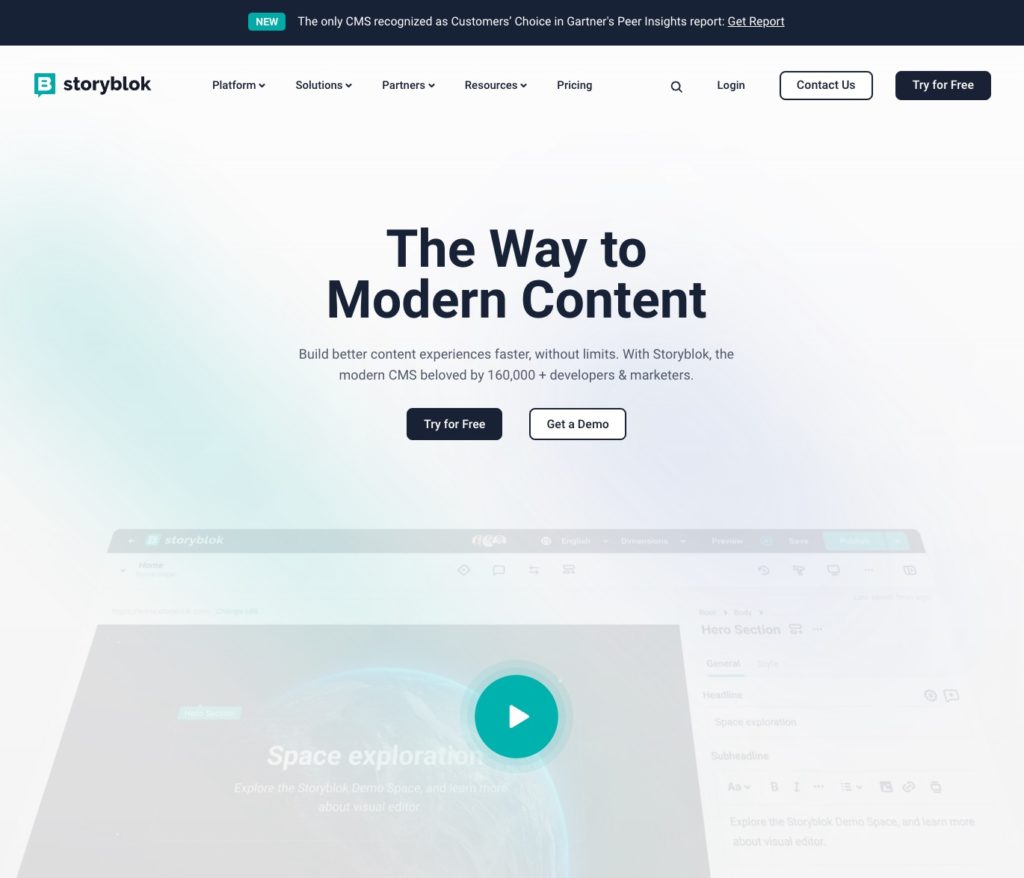
Best for:
Content managers and marketers.
Key Takeaways:
- Most popular headless CMS for marketers and content creators.
- Content is accessible across different countries, languages, and devices.
- Pricing is tailored, providing suitable options for individuals and small businesses.
Ease of Use:
Storyblok is distinctive compared to other headless CMS platforms since its features grant easier access to content managers. On top of that, content creators and developers possess the liberty to deviate from traditional CMS by a modern headless rule and also generate new content experiences in various platforms.
The Visual editor of Storyblok may look different from the general WYSIWYG editor, yet it is the nearest replication in comparison to other headless CMS systems. It offers drag and drop functionality, designated content blocks and variable customization choices available in the sidebar.
Customizability:
Just as Contentful, Storyblok grants you the opportunity to upgrade the Visual editor as desired. Using Storyblok’s well-organized and varied plug-in system, it is possible to customize the editor with new specifics such as color pickers and google map selectors.
Another intriguing feature of Storyblok is the extended content localization access. You are able to configure your own localization strategy, thus distributing content to various countries, languages and device types.
Security:
Storyblok, like Contentful, is hosted on AWS with its access control and data security system.
Using Storyblok, users are protected against cross-site scripting, brute force attacks, and SQL injections with continuous security tests, monthly recovery tests, and daily backups.
Pricing:
Other than the free use option for an individual, Storyblok presents a selection of pricing plans suitable for different users. It begins with a $7 monthly cost for personal projects moving to two tiers for starting and small businesses that charge $12 and $21 respectively per user per month. Moreover, there is an enterprise plan.
Average Cost: $0 to $21 per user
Brands Using Storyblok
EF Education First
For EF Education, a world-renowned education company with thousands of pages of content in multilingual versions, Storyblok was the answer. With its help, EF Education has been able to quickly launch a brand-new global multilingual website, something infeasible under traditional systems.
13. ConcreteCMS
ConcreteCMS is an open-source CMS created with the aim of filling a gap in the market. Concrete5 is not overly complicated or intimidating and not overly simplistic either. The perfect balance between ease of use and a comprehensive feature-set – that’s what ConcreteCMS offers.
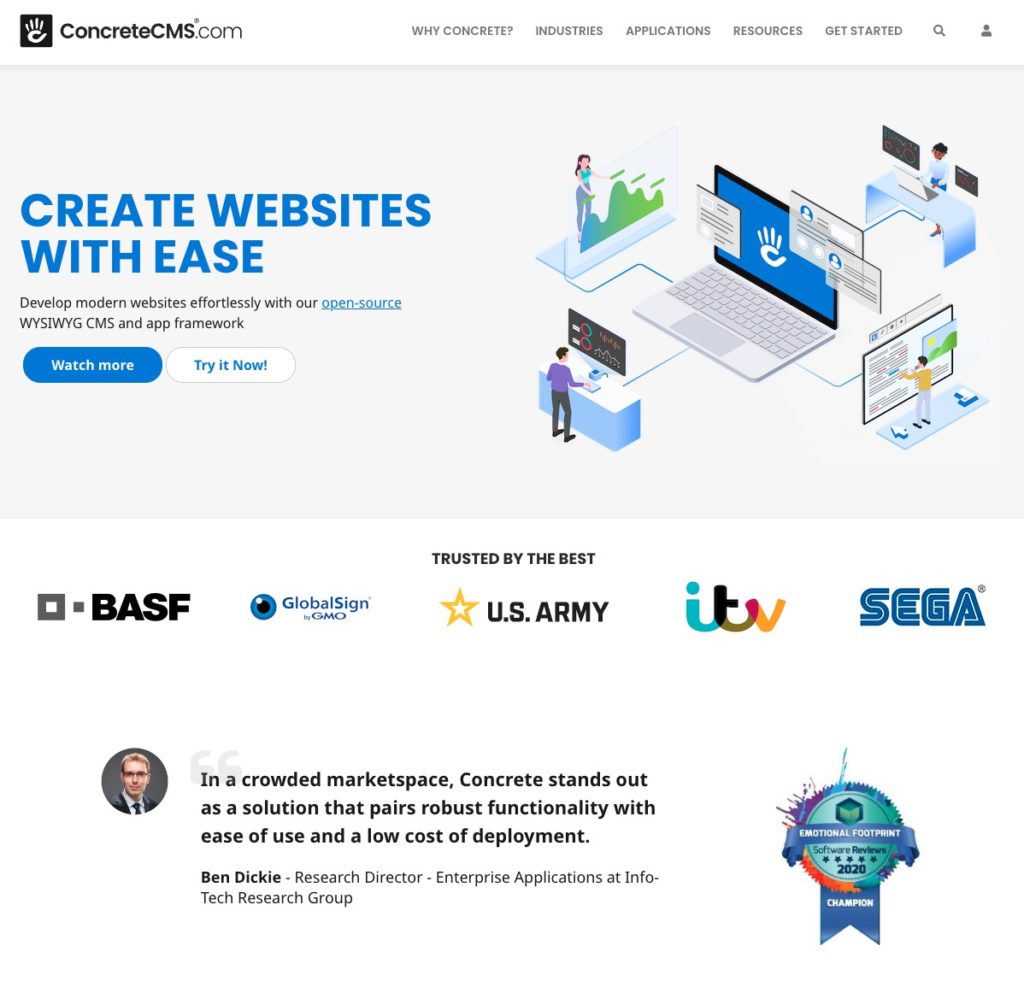
Best for
Beginners and those working in editorial roles.
Key Takeaways
- User-friendly, making it simple to use like a word processor.
- Small set of add-ons compared to other open-source options.
- Auditing and updating of software and add-ons help maintain website security.
Ease of Use
ConcreteCMS is designed with simplicity in mind, taking cues from the user-friendly word processors of today.
Using its block editor, adding content to the page is only a drag and drop away. Text, images, videos, interactive forms, surveys and much more can be added with no need to resort to coding.
Both beginner developers and more experienced professionals can build sophisticated web applications with ConcreteCMS – like extranets and online portals – and make it look simple and straightforward.
Customizability
ConcreteCMS is supplied with many features out of the box, including pre-made templates, custom form fields and an integrated commenting system.
If You feel like a feature is missing, you can find the perfect add-on from ConcreteCMS’s own Marketplace. While 600+ modules is far less compared to those available on other open-source platforms, it is a respectable number.
The selection of available themes is also limited – fewer than 100 are available.
Security
Just like other open-source solutions, a team of developers maintain the core of ConcreteCMS. However, website owners are responsible for applying additional measures to ensure their code is safe from any malicious activities.
ConcreteCMS offers some noteworthy features that make sure your website is kept safe; from one-click software version updates and automatic add-on notifications for example.
Pricing
Since ConcreteCMS is open-source, the only around the expense pertains to domain registration, hosting and any premium add-ons or themes You wish to purchase.
Domain registration and hosting is similar to other open-source platforms, in which a domain costs around $15/year and hosting can range from $3 to $60/month.
On average, a premium module costs $25 and a theme – $40. In the end, you’ll be looking at a yearly bill ranging from $50 to $800 for Your Concrete5 website.
Average cost: $50 to $800 per year
14. Contentstack
Similar to Contentful, Contentstack is a cloud-based web CMS used for headless solutions. It unlocks the best of content management and digital experience capabilities so that organizations can centrally manage and deliver content across digital channels, like desktops, smartphones, autos, and wearables.
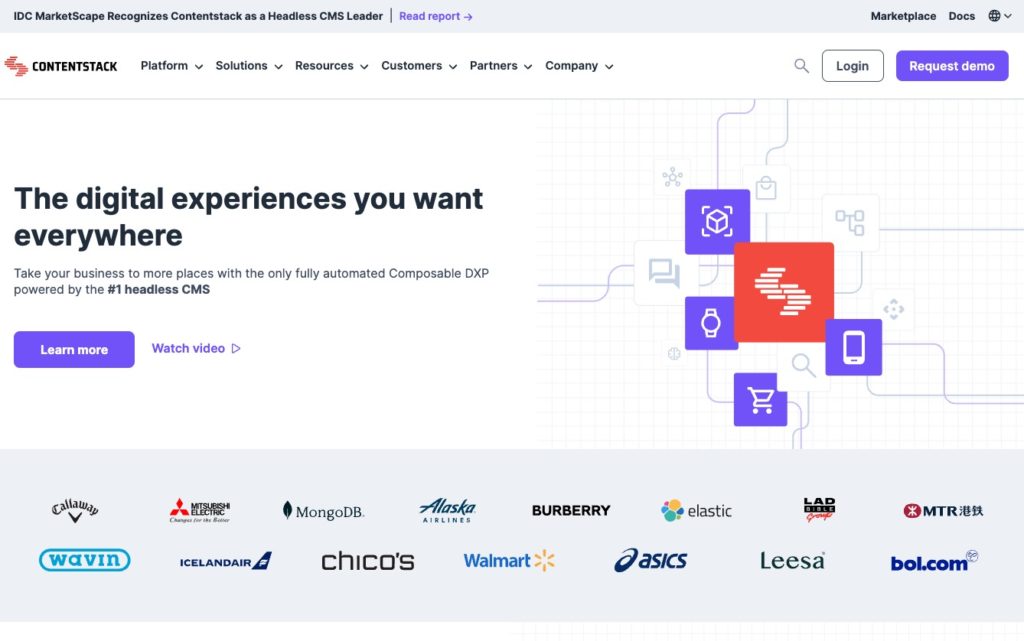
Best for
Large businesses which have a larger pool of resources in terms of developers.
Key Takeaways
- Advanced headless CMS for enterprise businesses
- Profound learning curve for non-developers
- Scalable and customizable content types, rich text editor, available programming languages, & integrations
- Substantial monthly fee
Ease of Use
Contentstack is crafted to be user-friendly & intuitive to use by developers & non-developers alike. Although, the latter would still need to go through a comprehensive learning process.
Content managers will find a rich text editor & a powerful scheduling & publishing tool to manage content without the help of a developer.
Meanwhile, developers will have to use the Content Type Builder to create content models that build the structure & formatting of the platform. This would mean that editing experiences are vastly different from a traditional CMS & its WYSIWYG editor.
If needed, users can access exclusive support from Contentstack through documentation, live chat, & customer success reps.
Customizability
Just as Contentful does, Contentstack grants developers the capabilities of creating content models that define how content appears on any target device like smartphones or smart watches. Content models also contribute to improving the formatting of the page.
With the rich text editor, developers can decide which formatting options to highlight & which ones to hide. Furthermore, they are free to use whatever programming language, frameworks, technologies, & integrations they need for the project.
Security
Security is also looked into by Contentstack with protocols that include protecting content over HTTPS via an access token & API key. Backup & versioning of content & assets is done daily & system scans are regularly executed to detect security vulnerabilities. Contentstack also makes use of AWS for improving its infrastructure.
Pricing
Contentstack offers three subscription plans. The Start plan costs $995 while the Grow plan costs $4,500 per month. For Scale plan, users will need to contact the vendor for pricing.
Average Cost: The plans sum up to be either $995 or $4,500 per month.
15. Webflow
Webflow is a “visual” content management system designed specifically for web designers requiring control over customizing sites, hosting, security, and performance.
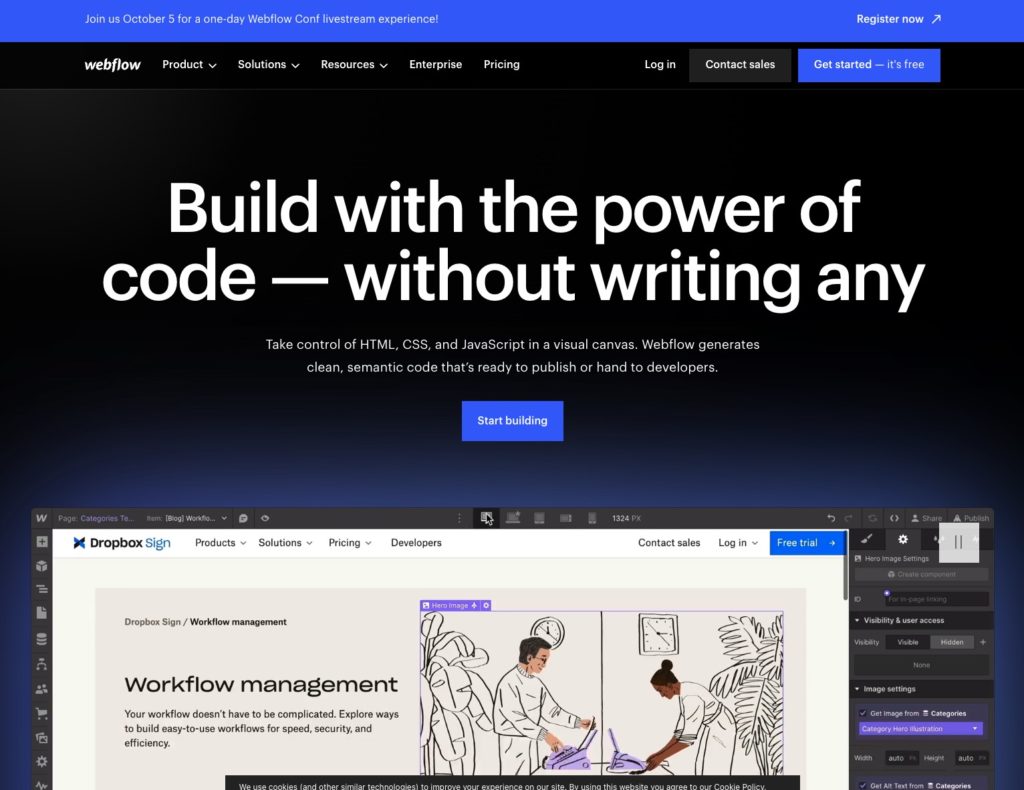
Best for
Webflow is ideal for experienced designers and marketers.
Key Takeaways
- Offers full control over site design
- Included AWS Shield and security features such as 2FA & SSL
- Assortment of various hosting plans with different price points
Ease of Use
The Webflow Designer comparable to using Photoshop in the browser. The user simply drags and drops elements onto a canvas and customizes them as they desire. While HTML and CSS are not necessary, knowledge of them will make the design process simpler.
When adding extra functionality, the site owner has two options; connecting to different platforms through an external integration or embedding code. To integrate, use Zapier and other platforms. To embed code, use pre-built pieces or custom blocks of code (premium plan or those with Webflow Hosting only).
Customizability
For full command of the site design, Webflow supplies various templates. Plus, users can directly customize color, background, typography, positioning, and more. All modified features can be converted to symbols and applied across the entire website.
Advanced users with HTML and CSS experience will find Webflow’s customization features unbeatable.
Security
Webflow-hosted websites receive AWS Shield protection, and include SSL certification, 2FA, role-based permissions, multilevel backups, and monitoring.
In addition, password protection for the whole site or individual pages is available with Webflow Hosting.
Pricing
Designing is free but a site plan and custom domain are necessary to deploy the website. Plans range from $12 to $212 per month for Ecommerce sites. Enterprise plans call for contacting Webflow straight for pricing details.
Average Cost: Usually, prices range from $12 to $212 per month, and there is a $15 annual fee for the domain. Additionally, enterprise plans are priced separately.
Deciding on the Best CMS for Your Needs
Although it is impossible to pinpoint the “Best CMS,” that would be compatible with all websites, you can find the most suitable CMS for your organization. Your preeminent platform should provide the CMS features you require, boost your teams’ capacity to regulate content, and eventually, grant you the capability to offer a desirable website experience for your customers.
